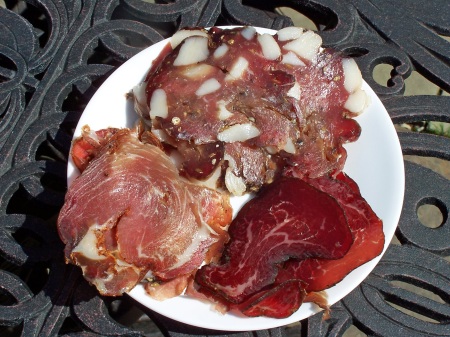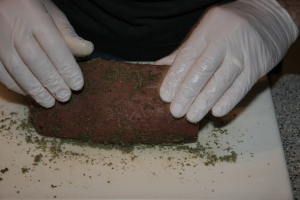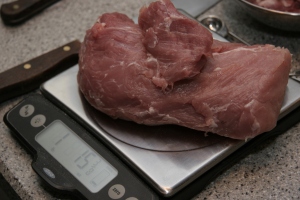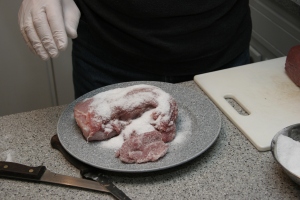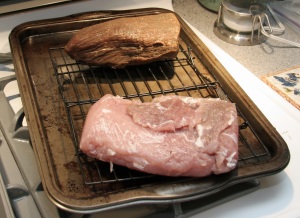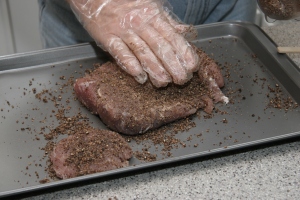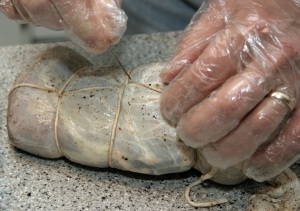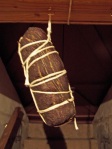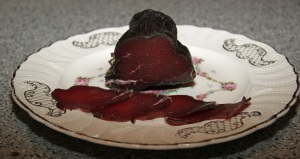We took advantage of Thursday’s lovely weather to take our pre-dinner wine and munchies on the patio. Some crackers and sharp cheddar for Ann; a little provolone and some home cured bresaola, capicola and finocchiona for me.
A simple pleasure all the more enjoyable because I made the product myself.
These salumi were started back while we were in the throes of the succession of snow storms this past winter.
For the bresaola, I kept everything the same as before but used a whole piece of eye round this time.
After the results of my first attempt at capicola I made some adjustments to the process and prepared a second attempt. I was very careful to adhere to a tight ratio of salt to meat, plus I added some of the seasonings halfway through the two week curing process. The object was to affect a good (and safe) cure but not over salt the meat as in the fist try. And I changed up the spice mix a little for more character and flavor.
To stretch myself a little, I tried a third product…a finocchiona. This is a Tuscan style salame flavored with lightly toasted fennel seeds. I bought and trimmed up a whole Boston butt (pork shoulder) and cut it into manageable chunks. These were tossed with the curing salt and spices and then run through the grinding attachment of my kitchen center. I also picked up a couple of pieces of fatback and coarsely chopped it up and blended it into the ground pork. The mixed fat and meat mixture was then stuffed into a casing and tied.
When it came to hanging the meats to dry, I again used our basement but added an inexpensive humidifier in an attempt to slow the process a little bit. If the relative humidity of the drying area is too low, the outside of the meat can dry to the point that it prevents the inside from properly drying. This is called “case hardening” and can lead to spoilage rather than curing.
Then came the hardest part…the waiting.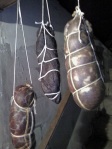
Just before Easter, I checked on the meats. By weight loss, they were pretty much on target. The finocchiona still felt a little soft in the middle when I squeezed it so I left it to hang a little longer. The bresaola was done. I cut it in half, wrapped and bagged it and put it in the refrigerator.
The capicola, I cut in half to see how well it had dried. It looked to need just a little more hanging time. I put the pieces in a brown paper bag (a trick I picked up at a demonstration on making capicola given by John Scarpati of the Mercer County Italian American Festival Association), tied it up and re-hung it in the basement.
More waiting.
After another 10 days, I checked the capicola. Fine!
Wrapped and bagged and into the icebox.
The Finocchiona still seemed a little soft in the middle but I was afraid the casing was getting too dry and wouldn’t let the center dry out appropriately. Cutting the sausage in half, I was surprised to find a pretty well cured center. The “give” appeared to come from the fact that I hadn’t compacted the filling as much as I should have. The meat smelled good; tasted fine; and I suffered no ill-effects from eating it. It too got wrapped, bagged and put into the refrigerator.
I will admit the Finocchiona could use some work. Rather than the hard salame I was aiming for, I had a “looser” but flavorful cured sausage. I hand cut the back fat to add to the “paste” (filling mixture) and could have diced it finer. The casing I ordered was about twice the diameter that I had anticipated, so the salame was thicker and that probably contributed to the uneven curing. The oversized casing did have one advantage in that I was able to hand stuff it. This was a good thing because I also discovered that my lightweight kitchen center was not quite up to the task of real sausage making. Something I’ll have to keep in mind if I’m going to continue to work in this particular area of charcuterie.
That said it wasn’t a total loss. There is a version of finocchiona that is more crumbly and somewhat “fresher” than your typical dry salame. “Sbriciolona” is something I’ve never actually tasted but it sounds close enough to my end result that I’m willing to call it that.
It’s doubtful that I’ll try to prepare any more salumi now that the weather is warming up. But I will continue to work in other areas of charcuterie until the fall.
